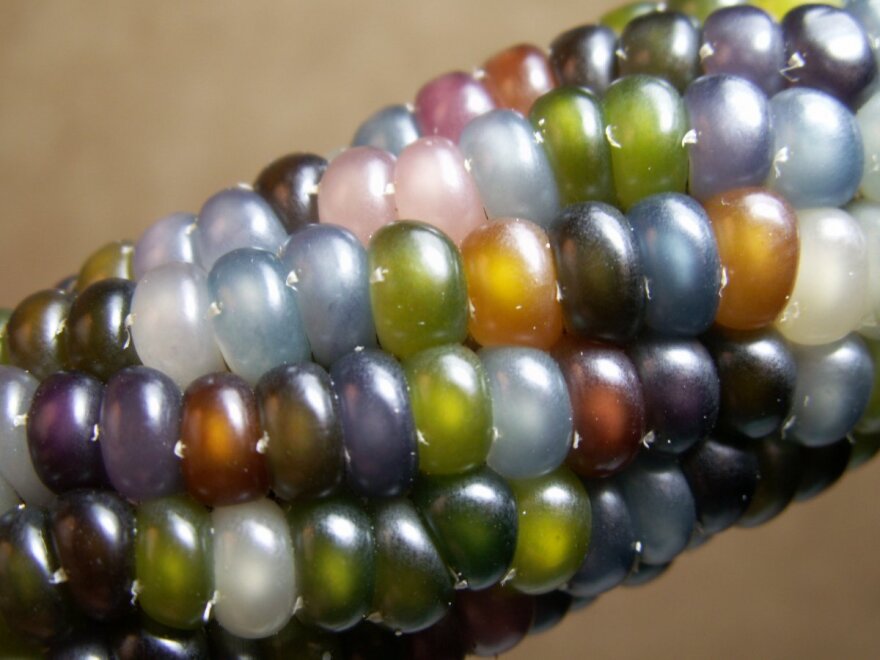Not many vegetables have a Facebook page at all, let alone with nearly 19,000 followers, but “Glass Gem” corn is special. Its translucent, rainbow-colored kernels made it an Internet sensation. Growers of this heritage crop say Glass Gem has inspired thousands of people to get involved with seed-saving and reconnect with ancient foodways. KNAU’s Melissa Sevigny tells the story of how this unique corn made its way from Oklahoma to Cornville, Arizona—and from there, to the world.
Brittle corn stalks border a backyard garden on Observatory Mesa in Flagstaff. They look dried-up and ordinary, but Carol Fritzinger says peeling back the husks is like Christmas morning. "This is the first one I pulled this year and it’s just—I don’t know—stunningly beautiful," she says, showing off a brightly colored corn cob, "with blue and green and purple and yellow."

Fritzinger has grown Glass Gem corn ever since she saw a photo of it a few years ago. She picks a cob off the stalk and unwraps its husk. "Oooh, this one's a pink and purple variety," she says, laughing. "You just never know!"

Because it’s wind pollinated, the corn will mix with other heirloom varieties to create wild new colors and even red and white swirls like peppermint candy. "Isn't it crazy?" asks Fritzinger. "It is so fun. I want everyone to grow it. I give as much seed away as people will take."
The colorful corn was bred by an Oklahoma man named Carl Barnes, who wanted to explore his Cherokee roots. He began working with ancient types of corn and rediscovered traits that had been lost to his tribe as well as the Osage and Pawnee. He brought two small ears to a native plant gathering, where the rainbow colors enthralled a grower named Greg Schoen.
Schoen recalls, "I went: Oh my god, I've got to get to know this guy."

Barnes and Schoen became friends. Schoen took a handful of kernels to his home in New Mexico and crossed them with Pueblo popcorn. Ears appeared with not only brilliant colors but a shiny glasslike hue. Schoen felt it was more than a pretty plant. It was a piece of the past that had nearly been lost.
He says, "That heritage is not only that you still preserve the genetic resource of all of that, it also has cultural memory, and that’s a powerful force."
Schoen says the corn’s genetics stretch back to ancient varieties lost to Native people in 1800s when they were forced to relocate to Oklahoma on the Trail of Tears. He felt the corn was a gift, so he gave away seeds to anyone who wanted them… including a couple that had just started a seed saving school in, of all places, Cornville, Arizona: Belle Starr and Bill McDorman.
Starr remembers, "We unveiled it at our first seed school." McDorman chimes in, "Yeah, it was almost October 1, 2010 when we went out to the front yard with our class and started opening it up. It was one of those transformational--it was beyond belief."
Starr adds, "People were crying in our class, literally crying, it was so beautiful."
A year later, McDorman and Starr took over directorship of Native Seeds/SEARCH in Tucson, a nonprofit group. They put a photo of the multicolored corn on the website with Greg Schoen’s original caption: “Glass Gem.” It spread like wildfire. Thousands of orders for seeds poured in.

McDorman says, "One ear of corn is that famous picture of Glass Gem. One little ear that’s now changing the world.... and has, in the end, been called the poster child for the whole return to heirloom seeds."
Starr and McDorman are now directors of the Rocky Mountain Seed Alliance, a group that saves seeds by giving them away through a network of “seed stewards.”
Starr says, "Seed saving is so magical and it takes you so many different places."
McDorman says, "That’s the point, in some ways, is that when you start saving seeds from something you’ve grown and then plant it again, you’re rejoining a ritual, a 10,000 year old ritual, that created all the foods we eat out of wild plants."
Glass Gem is not a sweet corn, but it’s great as popcorn or ground into flour. McDorman adds it to coffee, his personal twist on a traditional Mexican drink called pinole. But he says growing Glass Gem isn’t just about food or beauty. It’s about protecting stories and a sense of place.




